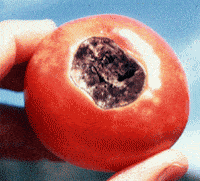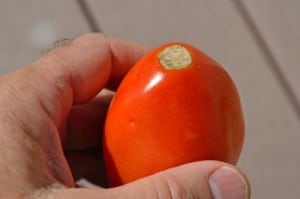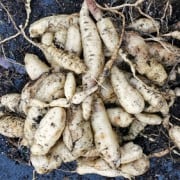Blossom End Rot – What To Do
Blossom end rot affects mainly tomatoes and peppers, but can affect other fruiting crops such as eggplant, watermelon and summer squash. This is a perennial problem, meaning that as a gardener, you will deal with this yearly in your garden. There are two approaches to working with blossom end rot – prevention and reaction, or a primary and secondary solution. Unfortunately, most gardeners only realize they have a problem when the fruit are showing black spots on the end. This is the acute phase – once there are problems – and immediate action is needed to prevent further damage to fruit that is just beginning to set.
We will look at the underlying causes of blossom end rot, along with what happens and what can be done about it in the prevention as well as the acute phase.
As mentioned, blossom end rot will affect more than just tomatoes and peppers, but we will focus mainly on those as this is what most gardeners’ experience. Just tuck the other varieties into the back of your mind, and you’ll have a jump start if you see it strike them. In reality, the prevention will most likely have a beneficial effect for everything as you will be creating an environment that won’t support the cause of the problem!
Blossom end rot is caused by a lack of enough available calcium in the fruit at the blossom end. What most often alerts us is a black spot or patch at the blossom end of the tomato or chile, opposite of the stem. This black spot is a secondary issue caused by a fungus attacking the weakened fruit. Contrary to what many think, we aren’t aiming for the eradication of the fungus and resulting black patch, but fixing and preventing the cause of the problem. Correcting the underlying issues that lead to the weakened fruit will automatically prevent the fungus from being able to attack.
Let’s start with the problem and work backwards, to better understand what is needed for both an acute fix and a preventative approach for blossom end rot. Calcium is a very important part of the growth process for plants and the proper development of high quality, tasty fruit as it contributes to healthy cell wall growth, insect resistance and helps to regulate many cell processes. Calcium is non-mobile in the plant once it is imported, meaning the plant can’t move it from one part of itself into the fruit, or from one part of the fruit to another. Thus, the tomato or chile plant needs a continuous supply of calcium as it grows, flowers and produce fruit all through the season.
Blossom end rot usually occurs early in the season with the first or second flush of fruit. It happens just when the plant is at maximum growth and is putting on the first fruit, with a second set of flowers on the way. It is in high gear and needs all of its nutrients available to be healthy, resist pests and disease, as well as grow lots of delicious tomatoes and peppers. The key to preventing blossom end rot is to supply a sufficient, steady amount of calcium to the plant so it can be transported into the fruit continuously. Problem solved!
Not so fast, just how can we make sure that the plant has a steady supply of calcium?
Here is where we branch off into the two approaches – the primary and the secondary. The primary, preventative approach is to have enough calcium in the soil that feeds the roots and is transported to the fruit throughout the growing season. That calcium in the soil must be ‘available’ meaning that the roots can actually absorb it and transport it where it is needed. Available means that it isn’t tied up by another mineral or a pH level that won’t ‘let go’ of it. There is more to the story than just adding a calcium amendment to the garden bed!
A very good example of this is where we live in central AZ, there is a decent amount of calcium in the soil that plates out on faucets and glassware as a calcium deposit. Conventional wisdom says not to worry about calcium because it is everywhere. That’s true, but the challenge we have is the pH of the soil is fairly alkaline at 8+ on the pH scale, so the calcium is ‘tied up’, or not available to the plants. This is proven by the weed populations we typically see that only grow in calcium deficient soils.
So what can be done? A comprehensive soil test is one of the best, first steps to take. This is much more than the simple NPK type of test done by university extension offices or the do-it-yourself test kits bought at the local garden center. A complete soil analysis is one that is collected and sent off to a recognized, professional lab that sends back a report on every mineral found along with recommendations on what direction to go and what nutrients to add in what form. They will usually cost from $25 to $75 range, depending on what analysis and information you need. There are several of these labs in the US; the two that we’ve worked with and are familiar with are Crop Services International and Texas Plant and Soil Lab. From this, you will have a very good indication of where to go next.
Fall is a great time to get your soil tested and amended in preparation for next spring’s season for a few reasons – the soil testing labs are generally not as busy, so results are quicker; and soil amendments will need some time to become integrated and available into the soil nutrients, so fall gives you the needed time, and it is easily incorporated into the traditional fall garden cleanup and prep.
Calcium is closely tied with magnesium, and this will be indicated on the soil analysis. More acidic soils, such as those generally found in the eastern states, will benefit from lime or calcium carbonate, while the more alkaline soils in the western states will need gypsum or calcium sulfate. Lime tends to raise the pH, while gypsum tends to lower it.
Water plays an often overlooked, but equally important, role in the blossom end rot saga. Inconsistent levels and rates of water will greatly vary the amount of calcium and other nutrients available to the plant, increasing the chance of diseases attacking the fruit like blossom end rot. This is one of the reasons we talk a lot about a drip system on a timer – it really helps even out the moisture levels in the soil and greatly reduces the stress on the entire garden, with the happy result of lowered amounts of nutrient and stress related problems. Of course, the weather can also play havoc with all of our carefully laid plans, as heavy and sudden rainfall can cause blossom end rot and splitting of tomatoes, along with a noticeable ‘wash-out’ of flavor and taste.
This is where the acute or secondary approach is needed. Calcium carbonate tablets, or anti-acid tablets (Tums or the equivalent) work great when a couple of them are inserted at the base of a tomato or chile plant, where they will dissolve and make the calcium available to the plant in just a few hours, saving this flush of fruit if done right after the rains, or the next set if done when blossom end rot is first noticed.
Another approach is to feed calcium directly to the roots through the drip system as a liquid fertilizer, usually with calcium chloride or calcium nitrate. This approach works very well in offsetting one of the most overlooked causes of blossom end rot – great weather. That’s right – excellent weather with moderate temperatures and lots of sunshine put the plants into overdrive, and their rapid growth can often simply outstrip the amount of available calcium in the soil, even if you have been proactive last fall. The calcium just cannot be taken up out of the soil fast enough, so feeding through the drip system can be a big bonus during these times. The secondary approach will always be needed, even if you’ve done your homework and amended the soil the previous fall.
Calcium isn’t absorbed very well by the leaves of a plant, especially older leaves. The roots are much better at absorption, plus they can transport the calcium faster than through a foliar approach. For these reasons, stay away from trying a foliar spray to supply calcium to your tomatoes.
Blossom end rot won’t ever quite go away, because of the reasons you’ve seen here. With some knowledge and practice, you can easily create a much better environment in the soil that supports the plants much more fully and then use the supplemental approach to keeping the calcium levels high enough to minimize blossom end rot and keep more of your hard work for your dining table instead of as scraps for the chickens or compost pile!




 © 2024 Terroir Seeds | Underwood Gardens
© 2024 Terroir Seeds | Underwood Gardens





You are correct about the reasons for BER and the association of moisture, since a plant under moisture stress will not take up Ca readily, unlike P and K. But, excess K fertilization, especially, and Mg will exacerbate the Ca deficiency since they compete at the root hair uptake point directly with Ca absorption.
Thanks Phil, you underscore the point of getting to know your soil’s condition and adjusting accordingly!
BER: The rest of the story –
While it is certainly true that BER is caused by Ca deficiency, the real question is what caused the deficiency? BORON is essential for the transport of Ca within the plant. Without B, the plant could be planted in lime but would be Ca deficient. In calcareous soils, B is rapidly tied up. In the slightly acidic soils which tomatoes prefer, the soil could indeed be Ca deficient, but also in B, as well.
Soil Organic Matter holds B and releases it to the roots, However, if the soil is B- deficient at the onset, adding OM will not cure the problem (unless it has B to begin with). While BER is a sure symptom of a lack of Ca, so the lack of Ca may only be a symptom of the lack of B.
Due to the decline of soil OM over the last 50+ years, we now see Boron deficiencies all the time in samples sent to us, with OM levels often much less than 1% in agricultural and unimproved garden soils. It has become so common, we now include a B assay as standard with our soil tests. Years ago, Boron toxicity used to be common in some areas. We now rarely see it.
Remember that B is a micronutrient, so too much will be toxic to the plant. B deficiency is most rapidly corrected with foliar spray. If you can’t easily get Solubor, borax (from the grocery store) contains about 11% B and is readily dissolved in water. Always apply B or any micronutrient judiciously and with a surfactant.
Remember, also, that while a soil may be highly calcareous, that does not mean that the Ca is available to the plant, as it may exist as insoluble or plant-unavailable compounds.
We have a paper on Boron available on http://www.AskThePlant.com under Agronomy Notes which goes into greater detail. You might also look at our Water Test Interpretation Guide for more info on B. Also available is a paper on tomatoes.
If you have any questions, please feel free to contact me directly at tpsl@aircanopy.net.
Frank, you’re getting ahead of me and letting the cat out of the bag! Seriously though, thanks for more details and helping to reinforce our stance on improving the health of the soil.
I have always sent my soil to the extension and didn’t know about the other labs. This is good info. I know my soil is very lacking in nutrients. Thank you.
You are welcome! I hope our information helps you in the garden next year.
We eat a lot of eggs. I started drying and pulverizing the shells and adding them either by top dress or root drench and have not had the blossom end rot again. I love to learn to “use what you have”.
Glad to see the recycling Susan! Too many gardeners forget the calcium resources they have in eggshells and buy additional calcium to add to the garden.